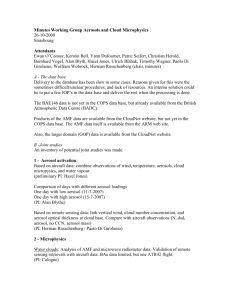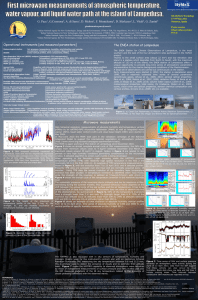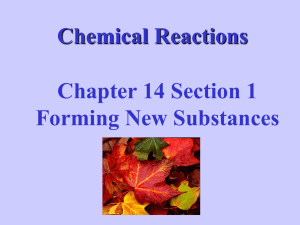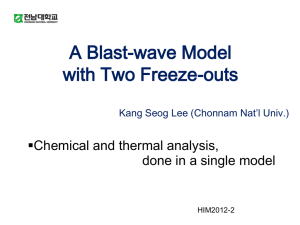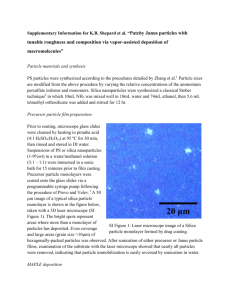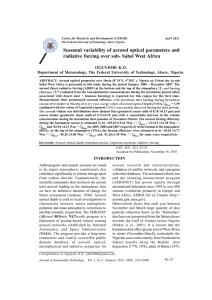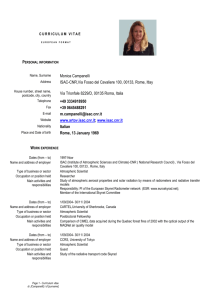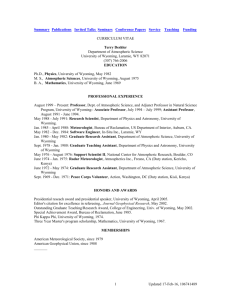S1. FARM description - Springer Static Content Server
advertisement
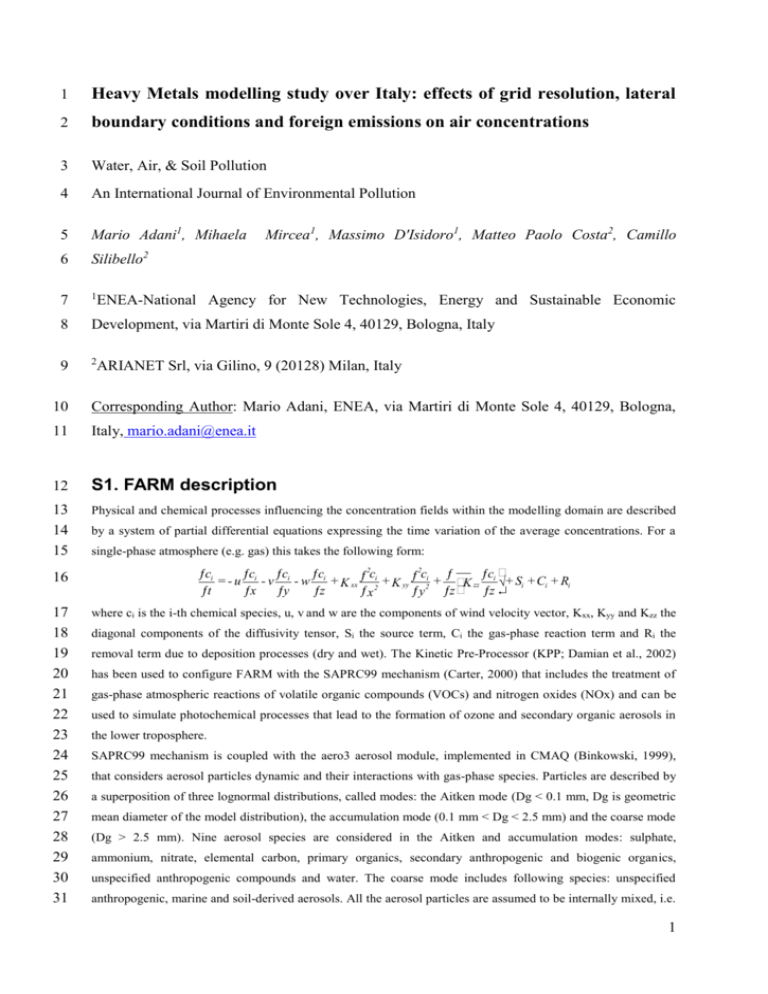
1 Heavy Metals modelling study over Italy: effects of grid resolution, lateral 2 boundary conditions and foreign emissions on air concentrations 3 Water, Air, & Soil Pollution 4 An International Journal of Environmental Pollution 5 Mario Adani1, Mihaela 6 Silibello2 7 1 8 Development, via Martiri di Monte Sole 4, 40129, Bologna, Italy 9 2 Mircea1, Massimo D'Isidoro1, Matteo Paolo Costa2, Camillo ENEA-National Agency for New Technologies, Energy and Sustainable Economic ARIANET Srl, via Gilino, 9 (20128) Milan, Italy 10 Corresponding Author: Mario Adani, ENEA, via Martiri di Monte Sole 4, 40129, Bologna, 11 Italy, mario.adani@enea.it 12 S1. FARM description 13 14 15 Physical and chemical processes influencing the concentration fields within the modelling domain are described 16 17 18 19 20 21 22 23 24 25 26 27 28 29 30 31 by a system of partial differential equations expressing the time variation of the average concentrations. For a single-phase atmosphere (e.g. gas) this takes the following form: 2 2 ¶ci ¶c ¶c ¶c c c ¶ æ ¶c ö = - u i - v i - w i + K xx ¶ 2i + K yy ¶ 2i + ç K zz i ÷ + Si + Ci + Ri ¶t ¶x ¶y ¶z ¶x ¶ y ¶z è ¶z ø where ci is the i-th chemical species, u, v and w are the components of wind velocity vector, Kxx, Kyy and Kzz the diagonal components of the diffusivity tensor, Si the source term, Ci the gas-phase reaction term and Ri the removal term due to deposition processes (dry and wet). The Kinetic Pre-Processor (KPP; Damian et al., 2002) has been used to configure FARM with the SAPRC99 mechanism (Carter, 2000) that includes the treatment of gas-phase atmospheric reactions of volatile organic compounds (VOCs) and nitrogen oxides (NOx) and can be used to simulate photochemical processes that lead to the formation of ozone and secondary organic aerosols in the lower troposphere. SAPRC99 mechanism is coupled with the aero3 aerosol module, implemented in CMAQ (Binkowski, 1999), that considers aerosol particles dynamic and their interactions with gas-phase species. Particles are described by a superposition of three lognormal distributions, called modes: the Aitken mode (Dg < 0.1 mm, Dg is geometric mean diameter of the model distribution), the accumulation mode (0.1 mm < Dg < 2.5 mm) and the coarse mode (Dg > 2.5 mm). Nine aerosol species are considered in the Aitken and accumulation modes: sulphate, ammonium, nitrate, elemental carbon, primary organics, secondary anthropogenic and biogenic organics, unspecified anthropogenic compounds and water. The coarse mode includes following species: unspecified anthropogenic, marine and soil-derived aerosols. All the aerosol particles are assumed to be internally mixed, i.e. 1 32 33 34 35 36 37 38 39 40 41 the chemical composition is the same for the particles of the same size, in a mode. Nucleation and growth of 42 S2. Precipitation scavenging module 43 44 45 The parameterization of wet deposition follows EMEP (2003) approach, including in-cloud and below-cloud 46 DCwet = -C 47 48 49 where P is the precipitation rate (kg/m2/s), z is the scavenging depth (assumed to be 1000 m), w is the water 50 DCwet = -C 51 52 where Wsub is the sub-cloud scavenging ratio. 53 DCwet = -C 54 where A = 5.2 m3/Kg/s is an empirical coefficient (a Marshall-Palmer size distribution is assumed for rain 55 drops), 56 aerosols by the raindrops. In Table S1 are reported in-cloud ( Win ) and sub-cloud ( Wsub ) scavenging ratios and 57 58 collection efficiencies ( E ) used in precipitation scavenging calculation for PAHs. existing particles trough condensation are the two pathways for increasing the total aerosol mass. Aerosol growth by condensation occurs in two steps: the production of condensable material (performed by the gas-phase chemical module) and the condensation and evaporation of ambient volatile species on aerosols. Particle collision and coagulation are the main processes that alter the aerosol size distribution. The thermodynamic equilibrium between gas and aerosol phases of condensable inorganic (ISOROPIA model: Fountoukis et al., 2007; Nenes et al.,1998) and organic species (SORGAM model: Shell et al. 2001) and the following chemical reactions within aerosols are responsible for the chemical composition of aerosols. Except for nucleation, where only inorganic compounds are considered, all aerosol dynamic processes include both inorganic and organic compounds. scavenging of gas and particles. The in-cloud scavenging of a soluble component of concentration C is computed as: Win × P Dz × rw density (1000 kg/m3) and Win is the in-cloud scavenging ratio. Below-cloud scavenging of gases is computed by means of a similar relationship: Wsub × P Dz × rw In case of particles, below-cloud scavenging is computed by means of Scott (1979) relationship: Vdr A×P E Vdr is the raindrop fall speed (assumed to be 5 m/s) and E is the size-dependent collision efficiency of 2 59 60 Tables Win (* 106) Wsub (* 106) E Gaseous phase 0.1 0.03 - Particulate 1.0 - 0.1 Component 61 Table S1: In-cloud (Win) and sub-cloud (Wsub) scavenging ratios and collection efficiencies ( E ) 62 used in precipitation scavenging calculation for PAHs. 3 63 Figures 64 65 Figure S1: Annual mean differences between NI and IT0 experiments: HMs concentration 66 [ng/m3] and emissions from diffuse sources [ng/m2/h] (right column). Panels from top to 67 bottom are referred to arsenic, cadmium, nickel and lead. 4 68 References 69 70 71 Binkowski, F. S,. 1999: The aerosol portion of Models-3 CMAQ. In Science Algorithms of the EPA Models-3 72 73 74 Carter, W.P.L., 2000. Documentation of the SAPRC-99 Chemical Mechanism for VOC Reactivity Assessment. 75 76 77 Damian, V., Sandu, A., Damian, M., Potra, F., Carmichael, G.R., 2002. The Kinetic PreProcessor KPP - A 78 79 Fountoukis, C. and Nenes, A.: ISORROPIA II: a computationally efficient thermodynamic equilibrium model 80 81 Schell B., Ackermann I. J., Hass H., Binkowski F. S., Abel A., (2001). Modeling the formation of secondary 82 83 Nenes A., Pandis S.N., Pilinis C., 1998: ISORROPIA: A new thermodynamic equilibrium model for multiphase 84 Scott B.C., 1979. Parametrization of sulphate removal by precipitation. J. Appl. Met., 17, 11379-11389. Community Multiscale Air Quality (CMAQ) Modeling System, edited by D.W. Byun, and J.K.S. Ching, EPA600/R-99/030, 1-23. Final Report to California Air Resources Board, Contract 92-329 and 95-308, SAPRC, University of California, Riverside, CA. Software Environment for Solving Chemical Kinetics. Computers and Chemical Engineering, 26(11), 15671579. for K+–Ca2+–Mg2+–NH4+–Na+–SO42−–NO3−–Cl−–H2O aerosols, Atmos. Chem. Phys., 7, 4639-4659, 2007 organic aerosol within a comprehensive air quality modeling system. J. Geophys. Res., 106, D22, 28275-28293. multicomponent inorganic aerosols. Aquat. Geoch., 4, 123-152. 5
